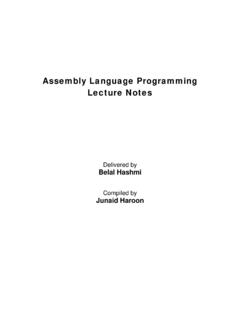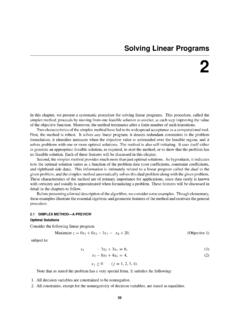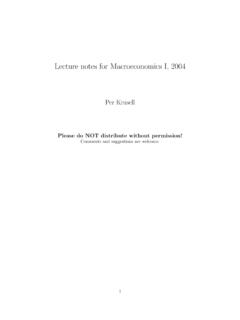Transcription of Chapter 3 The Neoclassical Growth Model - MIT …
1 Chapter 3. The Neoclassical Growth Model 75. Economic Growth : lecture notes In the Solow Model , agents in the economy (or the dictator) follow a simplistic linear rule for con . sumption and investment. In the Ramsey Model , agents (or the dictator) choose consumption and investment optimally so as to maximize their individual utility (or social welfare). The Social Planner In this section, we start the analysis of the Neoclassical Growth Model by considering the optimal plan of a benevolent social planner, who chooses the static and intertemporal allocation of resources in the economy so as to maximize social welfare. We will later show that the allocations that prevail in a decentralized competitive market environment coincide with the allocations dictated by the social planner. Together with consumption and saving, we also endogenize labor supply. 76. Angeletos Preferences Preferences are de ned over streams of consumption and leisure, x = {xt }.
2 T=0 , where xt = (ct , zt ), and are represented by a utility function U : X R, where X is the domain of xt , such that U (x) = U (x0 , x1 , ..). We say that preferences are recursive if there is a function W : X R R (often called the utility aggregator) such that, for all {xt } . t=0 , U (x0 , x1 , ..) = W [x0 , U (x1 , x2 , ..)]. We can then represent preferences as follows: A consumption-leisure stream {xt } . t=0 induces a utility stream {Ut } . t=0 according to the recursion Ut = W (xt , Ut+1 ). 77. Economic Growth : lecture notes We say that preferences are additively separable if there are functions t : X R such that .. U (x) = t (xt ). t=0. We then interpret t (xt ) as the utility enjoyed in period 0 from consumption in period t + 1. Throughout our analysis, we will assume that preferences are both recursive and additively separable. In other words, we impose that the utility aggregator W is linear in ut+1 : There is a function U : R R and a scalar R such that W (x, u) = U (x) + u.
3 Hence, Ut = U (xt ) + Ut+1 . or, equivalently, .. Ut = U (xt+ ). =0. is called the discount factor, with (0, 1). 78. Angeletos U is sometimes called the per-period utility or felicity function. We let z > 0 denote the maxi . mal amount of time per period. We accordingly let X = R+ [0, z]. We nally impose that U is Neoclassical , by which we mean that it satis es the following properties: 1. U is continuous and (although not always necessary) twice di erentiable. 2. U is strictly increasing and strictly concave: Uc (c, z) > 0 > Ucc (c, z). Uz (c, z) > 0 > Uzz (c, z). 2. Ucz < Ucc Uzz 3. U satis es the Inada conditions lim Uc = and lim Uc = 0. c 0 c . lim Uz = and lim Uz = 0. z 0 z z 79. Economic Growth : lecture notes Technology and the Resource Constraint We abstract from population Growth and exogenous technological change. The time constraint is given by zt + lt z. We usually normalize z = 1 and thus interpret zt and lt as the fraction of time that is devoted to leisure and production, respectively.
4 The resource constraint is given by ct + it yt 80. Angeletos Let F (K, L) be a Neoclassical technology and let f ( ) = F ( , 1) be the intensive form of F. Output in the economy is given by yt = F (kt , lt ) = lt f ( t ), where kt t =. lt is the capital-labor ratio. Capital accumulates according to kt+1 = (1 )kt + it . (Alternatively, interpret l as e ective labor and as the e ective depreciation rate.). Finally, we impose the following natural non-negativitly constraints: ct 0, zt 0, lt 0, kt 0. 81. Economic Growth : lecture notes Combining the above, we can rewrite the resource constraint as ct + kt+1 F (kt , lt ) + (1 )kt , and the time constraint as zt = 1 lt , with ct 0, lt [0, 1], kt 0. 82. Angeletos The Ramsey problem The social planner chooses a plan {ct , lt , kt+1 } . t=0 so as to maximize utility subject to the resource constraint of the economy, taking initial k0 as given: .. max U0 = t U (ct , 1 lt ).
5 T=0. ct + kt+1 (1 )kt + F (kt , lt ), t 0, ct 0, lt [0, 1], kt+1 0., t 0, k0 > 0 given. 83. Economic Growth : lecture notes Optimal Control Let t denote the Lagrange multiplier for the resource constraint. The Lagrangian of the social planner's problem is .. L0 = t U (ct , 1 lt ) + t [(1 )kt + F (kt , lt ) kt+1 ct ]. t=0 t=0. Let t t t and de ne the Hamiltonian as Ht = H(kt , kt+1 , ct , lt , t ) U (ct , 1 lt ) + t [(1 )kt + F (kt , lt ) kt+1 ct ]. We can rewrite the Lagrangian as .. t L0 = {U (ct , 1 lt ) + t [(1 )kt + F (kt , lt ) kt+1 ct ]} = t Ht t=0 t=0. or, in recursive form, Lt = Ht + Lt+1 . 84. Angeletos Given kt , ct and lt enter only the period t utility and resource constraint; (ct , lt ) thus appears only in Ht . Similarly, kt ,enter only the period t and t + 1 utility and resource constraints; they thus appear only in Ht and Ht+1 . Lemma 9 If {ct , lt , kt+1 } . t=0 is the optimum and { t }t=0 the associated multipliers, then H.
6 T . (ct , lt ) = arg max H(kt , kt+1 , c, l, t ). c,l taking (kt , kt+1 ) as given, and Ht + Ht+1.. kt+1 = arg max . H(kt , k , ct , lt , t ) + H(k , kt+2 , ct+1 , lt+1 , t+1 ). k taking (kt , kt+2 ) as given. We henceforth assume an interior solution. As long as kt > 0, interior solution is indeed ensured by the Inada conditions on F and U. 85. Economic Growth : lecture notes The FOC with respect to ct gives L0 Ht Ht = t =0 = 0 Uc (ct , zt ) = t ct ct ct The FOC with respect to lt gives L0 Ht Ht = t =0 = 0 Uz (ct , zt ) = t FL (kt , lt ). lt lt lt Finally, the FOC with respect to kt+1 gives . L0 t Ht Ht+1 Ht+1. = + = 0 t + =0 . kt+1 kt+1 kt+1 kt+1. t = [1 + FK (kt+1 , lt+1 )] t+1. 86. Angeletos Combining the above, we get Uz (ct , zt ). = FL (kt , lt ). Uc (ct , zt ). and Uc (ct , zt ). = 1 + FK (kt+1 , lt+1 ). Uc (ct+1 , zt+1 ). Both conditions impose equality between marginal rates of substitution and marginal rate of transfor.
7 Mation. The rst condition means that the marginal rate of substitution between consumption and leisure equals the marginal product of labor. The second condition means that the marginal rate of intertemporal substitution in consumption equals the marginal capital of capital net of depreciation (plus one). This last condition is called the Euler condition. 87. Economic Growth : lecture notes The envelope condition for the Pareto problem is (max U0 ) L0. = = 0 = Uc (c0 , z0 ). k0 k0. More generally, t = Uc (ct , lt ). represents the marginal utility of capital in period t and will equal the slope of the value function at k = kt in the dynamic- programming representation of the problem . 88. Angeletos Suppose for a moment that the horizon was nite, T < . Then, the Lagrangian would be L0 =. T t t=0 Ht and the Kuhn-Tucker condition with respect to kT +1 would give L HT. = T 0 and kT +1 0, with complementary slackness.
8 KT +1 kT +1. equivalently T = T T 0 and kT +1 0, with T T kT +1 = 0. The latter means that either kT +1 = 0, or otherwise it better be that the shadow value of kT +1 is zero. When T = , the terminal condition T T kT +1 = 0 is replaced by the transversality condition lim t t kt+1 = 0, t . which means that the (discounted) shadow value of capital converges to zero. Equivalently, lim t Uc (ct , zt )kt+1 = 0. t . 89. Economic Growth : lecture notes Proposition 10 The plan {ct , lt , kt } . t=0 is a solution to the social planner's problem if and only if Uz (ct , zt ). = FL (kt , lt ), ( ). Uc (ct , zt ). Uc (ct , zt ). = 1 + FK (kt+1 , lt+1 ), ( ). Uc (ct+1 , zt+1 ). kt+1 = F (kt , lt ) + (1 )kt ct , ( ). for all t 0, and k0 > 0 given, and lim t Uc (ct , zt )kt+1 = 0. ( ). t . Remark: We proved necessity of ( ) and ( ) essentially by a perturbation argument, and ( ) is just the constraint. We did not prove necessity of ( ), neither su ciency of this set of conditions.
9 See Acemoglu (2007) or Stokey-Lucas for the complete proof. Note that the ( ) can be solved for lt = l(ct , kt ), which we can then substitute into ( ) and ( ). We are then left with a system of two di erence equations in two variables, namely ct and kt . The intitial condition and the transversality condition then give the boundary conditions for this system. 90. Angeletos Dynamic Programing Consider again the social planner's problem . For any k > 0, de ne .. V (k) max t U (ct , 1 lt ). t=0. subject to ct + kt+1 (1 )kt + F (kt , lt ), t 0, ct , lt , (1 lt ), kt+1 0, t 0, k0 = k given. V is called the value function. 91. Economic Growth : lecture notes The Bellman equation for this problem is V (k) = max U (c, 1 l) + V (k ). c + k (1 )k + F (k, l). k 0, c [0, F (k, 1)], l [0, 1]. Let [c(k), l(k), G(k)] = arg max{..}. These are the policy rules. The key policy rule is G, which gives the dynamics of capital.
10 The other rules are static. 92. Angeletos De ne k by the unique solution to k = (1 )k + F (k, 1). and note that k represents an upper bound on the level of capital that can be sustained in any steady state. Without serious loss of generality, we will henceforth restrict kt [0, k]. Let B be the set of continuous and bounded functions v : [0, k] R and consider the mapping T : B B de ned as follows: T v(k) = max U (c, 1 l) + v(k ). c + k (1 )k + F (k, l). k [0, k], c [0, F (k, 1)], l [0, 1]. The conditions we have imposed on U and F imply that T is a contraction mapping. It follows that T has a unique xed point V = T V and this xed point gives the solution. 93. Economic Growth : lecture notes The Lagrangian for the DP problem is L = U (c, 1 l) + V (k ) + [(1 )k + F (k, l) k c]. The FOCs with respect to c, l and k give L. = 0 Uc (c, z) = . c L. = 0 Uz (c, z) = FL (k, l). l L. = 0 = Vk (k ). k . The Envelope condition is L.


















